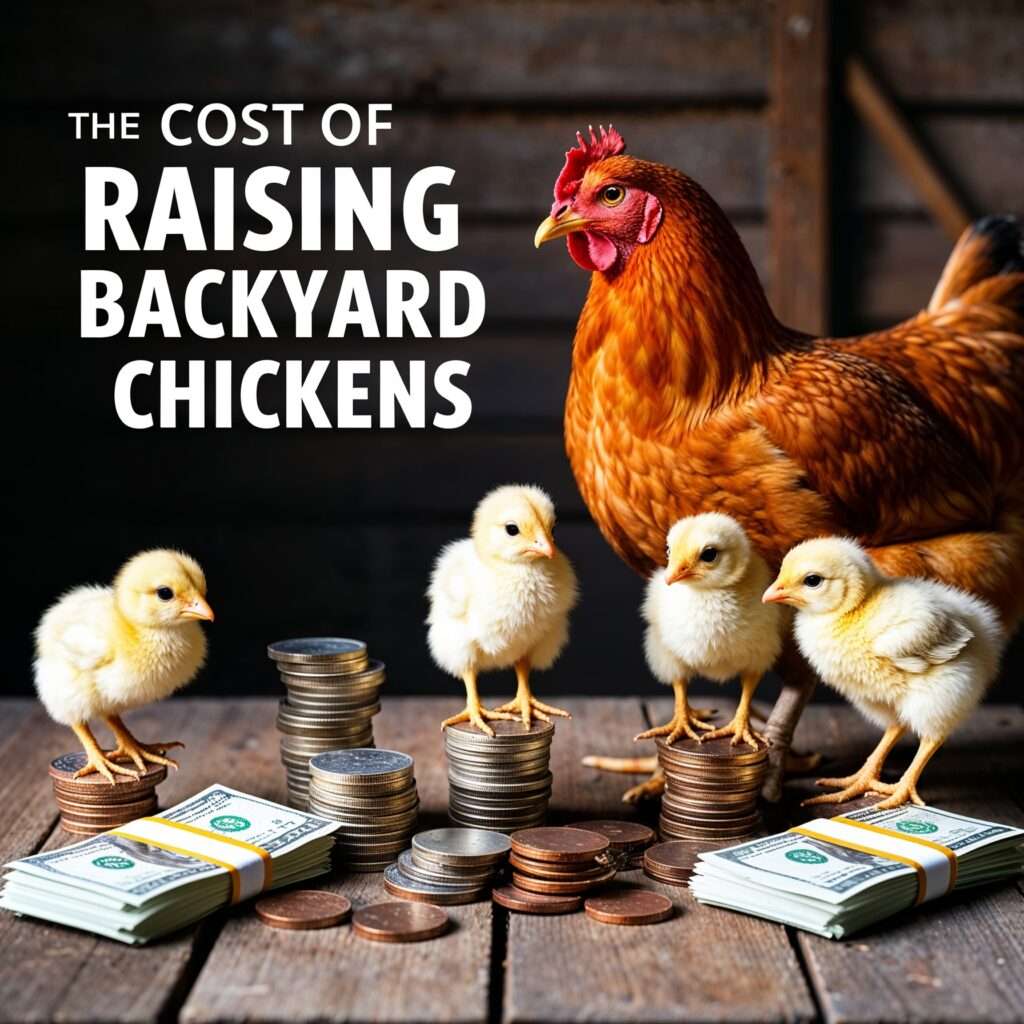
"An image showcasing a red hen and baby chicks standing on stacks of coins and bundles of cash, representing the financial considerations of backyard chicken keeping."
Raising backyard chickens is a rewarding experience, but it’s important to understand the cost of raising backyard chickens before you begin. While the benefits of fresh eggs, natural pest control, and sustainability are enticing, knowing the upfront and ongoing expenses will help you prepare. This guide dives deeper into the financial considerations so you can decide if raising chickens is right for you.
Initial Costs of Raising Backyard Chickens: Coop, Feeders, and Supplies”
Coop and Run: Key Costs for Raising Backyard Chickens
A sturdy coop and run are essential for keeping your flock safe, comfortable, and productive.
- Pre-Made Coops: These range from $300 to $1,000 depending on size and materials. Look for coops that are predator-proof and ventilated but insulated for winter.
- DIY Coops: Building your own coop from recycled wood or pallets can cut costs to $200 or less, but make sure your design includes key features like nesting boxes, roosting bars, and a predator-proof door.
- Chicken Run: A secure run allows chickens to roam freely while staying safe from predators. Expect to spend $100 to $500 on fencing, depending on the size of your run.
Insight: A coop should provide at least 2–3 square feet of space per chicken inside and 8–10 square feet per chicken in the run. Overcrowding leads to stress and health issues, so investing in adequate space up front prevents costly vet bills later.
Feeders and Waterers: Essential Costs for Raising Chickens
Every flock needs reliable feeders and waterers.
- Simple Designs: Basic feeders and waterers cost $20 to $50 each. These are good for small flocks.
- Automatic Systems: Larger flocks benefit from automated or no-spill systems, which cost upwards of $100 but reduce feed waste and cleaning time.
Insight: While automatic options may seem costly initially, they pay off by ensuring consistent food and water access, especially if you travel or have a busy schedule.
Bedding and Nesting Boxes for Backyard Chickens
- Bedding Materials: Options like straw, wood shavings, or sand keep the coop clean and comfortable. A bale of straw costs $5 to $10 and needs monthly replacement for a small flock.
- Nesting Boxes: Each nesting box (costing $10–$50) can support 3–4 hens for egg-laying.
Insight: Avoid cedar shavings as they can irritate chickens’ respiratory systems. Instead, use pine or straw for better health and odor control.
4. Chickens
The cost of chickens depends on their breed and age:
- Chicks: These cost $3–$5 each but require additional care like heat lamps and a brooder.
- Pullets: A more beginner-friendly option, pullets (young hens close to laying age) cost $15–$25 each and save on brooding setup.
Insight: Start with beginner-friendly breeds like Buff Orpingtons or Rhode Island Reds, which are hardy, docile, and reliable layers.
5. Heat Lamps and Brooder for Chicks
If you’re starting with chicks, you’ll need:
- Heat Lamp: Costs $15–$25 and ensures chicks stay warm during their first few weeks.
- Brooder: A simple brooder (like a plastic tote or cardboard box) can be set up for $20–$50.
Insight: Chicks require temperatures of 95°F in their first week, gradually decreasing by 5°F each week. Investing in a reliable heat lamp prevents chick losses.
Managing the Ongoing Costs of Raising Backyard Chickens: Feed and Health
Chicken Feed Costs: The Ongoing Expense of Raising Backyard Chickens
Feed is your largest ongoing expense:
- Cost: A 50-pound bag costs $15–$25.
- Consumption: Each chicken eats about 1/4 pound of feed daily. A flock of 4–6 chickens will need a bag every 4–6 weeks.
Insight: Supplementing feed with kitchen scraps, garden trimmings, or free-ranging can lower costs and improve chicken health. Avoid processed or sugary foods, which can harm their digestive systems.
2. Bedding Replacement
Bedding keeps the coop clean and odor-free:
- Cost: Replacing straw or wood shavings costs $5–$15 per month.
- Frequency: Cleaning the coop every 1–2 weeks prevents ammonia buildup, which can harm chickens’ respiratory systems.
Insight: Deep litter bedding methods can save money by allowing bedding to compost in place, creating a natural heat source during winter.
3. Health Care and Supplements
Keeping chickens healthy involves occasional costs:
- Dewormers/Vitamins: Budget $20–$50 annually for a small flock.
- Vet Visits: While rare, veterinary care for injuries or illnesses can cost $50–$200.
Insight: Preventive care, like cleaning the coop and providing grit or oyster shells for digestion, reduces the need for costly vet visits.
4. Water and Electricity
- Water: Costs are minimal but ensure fresh water daily.
- Electricity: Heat lamps or coop lighting during winter can add $10–$20 per month to your utility bill.
Insight: Solar-powered coop lights are an eco-friendly alternative for reducing electricity costs while maintaining egg production in winter.
Unexpected Costs in the Cost of Raising Backyard Chickens
1. Predator Protection
Strengthening your coop or run can cost $50 to $200:
- Hardware cloth is more durable than chicken wire for predator-proofing.
- Electric fencing is useful in areas with high predator activity.
Insight: Predators are persistent. Spending on quality protection saves you the heartbreak and financial loss of losing chickens.
2. Coop Repairs and Maintenance
Coops experience wear and tear over time:
- Budget: $50–$100 annually for repairs or upgrades.
- Weatherproofing: Adding tarps or insulation can prevent weather-related damage.
Insight: Regular maintenance ensures your coop lasts years longer, reducing long-term costs.
Is the Cost of Raising Backyard Chickens Worth It?
The cost of raising backyard chickens varies based on flock size and setup, but here’s an estimate for a flock of 4–6 hens:
- Initial Costs: $300–$1,500 (coop, chickens, supplies).
- Ongoing Costs: $200–$400 annually (feed, bedding, healthcare).
- Unexpected Costs: $50–$200 annually (repairs, predator-proofing).
Benefits:
- Fresh Eggs: Each hen lays 200–300 eggs annually, reducing grocery bills.
- Pest Control: Chickens naturally control insects, cutting pesticide costs.
- Compost: Chicken manure enriches garden soil, saving on fertilizer.
- Sustainability: Feeding kitchen scraps to chickens reduces waste.
Insight: While raising chickens involves costs, the rewards—like self-sufficiency, sustainability, and fresh eggs—make it worthwhile for many.

Final Thoughts on the Cost of Raising Backyard Chickens
Understanding the cost of raising backyard chickens ensures you’re prepared for the investment. Whether you’re motivated by fresh eggs, a greener lifestyle, or the joy of keeping a flock, planning for these costs will set you up for success. Raising chickens can be a fulfilling journey that pays off in more ways than one.
DARWIN’S TAKE
Chickens aren’t just clucking lawn ornaments—they’re a mirror to the systems we rely on. The cost of raising backyard chickens isn’t merely financial; it’s a cost of independence, a question of whether you’re ready to stop outsourcing your food security to factory farms and step into the messy, beautiful chaos of self-reliance.
Every egg laid isn’t just breakfast—it’s a rebellion against the sterile uniformity of supermarket shelves. The dollars you spend on coops and feed are less about expense and more about investing in the quiet satisfaction of knowing exactly where your food comes from.
Sure, chickens demand your time, your care, and yes, your cash. But what they give back—fresh eggs, pest control, a connection to something primal—is priceless. The question isn’t whether chickens are worth the cost. It’s whether freedom, sustainability, and a yard that hums with life are.
Chickens don’t just live in your backyard—they change the way you live in the world. Are you ready for that?
Sources and Related Reading
For a comprehensive understanding of the financial aspects of raising backyard chickens, consider the following resources:
- “How Much Do Chickens Cost?”
Backyard Poultry Magazine
This article provides a detailed breakdown of the initial and ongoing expenses associated with keeping chickens.
Read the article here - “How Much Does It Cost to Raise Chickens for Eggs?”
Mother Earth News
An analysis of the costs involved in raising chickens for egg production, including feed and infrastructure expenses.
Explore the guide - “The True Cost of Raising Chickens for Eggs”
Morning Chores
This resource compares the expenses of raising chickens to the cost of purchasing store-bought eggs, helping you assess financial viability.
Learn more - “Beginner’s Guide to Raising Backyard Chickens”
The Happy Chicken Coop
A comprehensive guide for newcomers, offering budgeting tips and cost-saving strategies for starting your own flock.
Visit the article - “Chicken Economics: The Cost of Keeping Chickens”
Mother Earth News
An exploration of the economic considerations of chicken keeping, including hidden costs and long-term investments.
Read the article here
These articles provide valuable insights into the financial commitments involved in raising backyard chickens, aiding you in making informed decisions.
More Reading on Paranoid Prophet
Dive deeper into related topics on raising chickens with these articles from Paranoid Prophet:
- How Much Space Do Chickens Need? Best Guide for Healthy Backyard Flocks
Learn the space requirements to ensure your flock thrives. - Benefits of Raising Backyard Chickens
Discover how raising chickens improves self-sufficiency and sustainability. - Best Chicken Breeds for Beginners
Find out which chicken breeds are best for new keepers. - Can Chickens Eat Pumpkins? The Health Benefits and Risks Explained
Learn about seasonal treats and safe food options for your flock.
FAQ: Cost of Raising Backyard Chickens
1. How much does it cost to start raising backyard chickens?
The initial cost of raising backyard chickens varies based on your setup. Expect to spend:
- Coop: $200–$1,000 (or less if DIY).
- Run: $100–$500.
- Feeders and waterers: $20–$50 each.
- Chickens: $3–$25 per bird, depending on age and breed.
- Total initial costs: $300–$1,500, depending on your choices.
2. How much does it cost to feed chickens monthly?
On average, a single chicken eats about 1/4 pound of feed per day. A 50-pound bag of feed costs $15–$25 and lasts 4–6 weeks for a small flock of 4–6 chickens. Monthly feed costs for a small flock are around $20–$40.
3. Are there any unexpected costs with raising chickens?
Yes, unexpected expenses may include:
- Predator-proofing ($50–$200 for materials like hardware cloth or fencing).
- Veterinary care ($50–$200 per visit).
- Coop repairs or upgrades ($50–$100 annually). Planning for these costs ensures you’re prepared for emergencies.
4. Can raising backyard chickens save money in the long run?
Raising chickens can save money on eggs, especially with consistent egg-laying breeds. A flock of 4–6 hens can produce 800–1,800 eggs annually, reducing grocery bills. However, the initial setup costs mean it could take a few years to break even. Non-monetary benefits like fresh eggs, pest control, and sustainability often make it worthwhile.
5. How can I reduce the cost of raising chickens?
Here are a few cost-saving tips:
- Use recycled materials to build a coop.
- Feed chickens kitchen scraps or allow them to free-range to reduce feed costs.
- Use deep litter bedding methods to save on cleaning materials.
- Start with pullets instead of chicks to skip brooder setup costs.
6. What breeds are the most cost-effective to raise?
For beginners and those looking for maximum egg production, consider breeds like:
- Rhode Island Reds: Hardy and prolific layers of 250–300 eggs per year.
- Leghorns: Produce up to 320 eggs annually with lower feed consumption.
- Australorps: Reliable layers with excellent temperament. These breeds offer great returns on your investment.
7. Do I need electricity in my coop, and how much does it cost?
Electricity is needed for:
- Heat lamps (if raising chicks or in cold climates).
- Lighting to maintain egg production during shorter winter days. Costs for electricity range from $10–$20 per month, depending on usage and climate.
8. Are there grants or subsidies available for raising backyard chickens?
Some cities or local governments offer grants or rebates for urban farming or sustainable living projects, which could include chicken coops or predator-proofing. Check with your local agricultural office or sustainability programs for options.
9. How can chickens help reduce other household costs?
Chickens provide several cost-saving benefits:
- Reduce food waste by eating kitchen scraps.
- Produce nutrient-rich manure, reducing the need to buy garden fertilizers.
- Naturally control pests like insects and weeds, lowering pesticide costs.
10. What are the long-term costs of raising chickens?
Long-term costs include:
- Feed and bedding: $200–$400 annually for a small flock.
- Maintenance and repairs: $50–$100 annually.
- Healthcare: $20–$50 per year for basic supplements and deworming. Overall, expect ongoing expenses to average $300–$600 annually for a 4–6 chicken flock.


